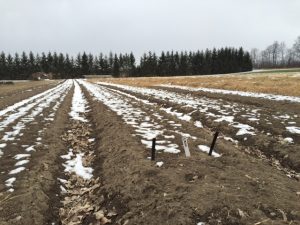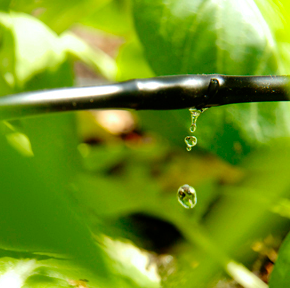Farming for over 30 years in Shoreham, Will and Judy Stevens have noticed climate changes at their organic farm – Golden Russet Farm. From 1985 to 1995, Will recalls having a number of late frosts in May and that the first frost date typically occurred in early September. However, in the last 20 years, there’ve been only two years where the frost date has been as early as that, with the typical frost date extending to October.
Our growing season is longer and we have more frost-free days; we’ve had years where we’ve had no May frosts and more notably the fall has gotten longer.
In addition to the changes in frost dates, Golden Russet Farm has experienced both extreme storm events, as well as excessively wet growing seasons. 2011 was a persistently wet year, starting in spring and culminating with Tropical Storm Irene in August. Golden Russet Farm was in the red that year with a $34K loss. Much of the crop loss was due to soil saturation, not event flooding per se. The farm’s soils are a layer of loam on top of a layer of clay of varying thickness (2 to14 inches), which inhibits drainage from the root zone. Learning from 2011, Will says,
I’ll take a dry year over a wet year any day. It’s easier to manage dry conditions with irrigation than to be at the mercy of heavy rain events. We’ve noticed over the years that almost every rain event is a violent event. We used to get gentle rain. Now it’s thunderstorms and violent events. With 2.5 inches of rain in an hour, we needed to get rid of the surface water as we didn’t want standing water.
In 2012, working with their existing equipment (a three-bottom moldboard plow), the Stevens built up raised beds by alternating plow passes with 12 inch dead furrows. This roughly formed 36 inch wide ‘beds’. Going to this type of raised bed did add some complications. After soil smoothing and mulching, the Stevens ended up with a final bed width of 30 inches, but this width was too narrow for the transplanter and cultivators as they risked sliding off the beds.
After several years making adjustments, the Stevens invested in a three-point hitch bed shaper in 2015, which can be pulled with their tractor to shape 34-inch beds, moving soil up from the wheel track, so that only two passes need to be made with the press pans. The 34 inch top width of the beds matches up with the cultivator and transplanter. At the same time, drip irrigation tubing is put into place as the beds are made.
The Stevens started by planting carrots, lettuce, beets, and spinach in some of the raised beds, and brassicas, broccoli and corn in others. In 2016, the Stevens had 12 raised beds of tomatoes, cucumbers, melons, peppers, flowers, and 11 raised beds of garlic across their 1.5 acre field.
With the bed shaper, there’s no need to till the topsoil. In fall 2016, the Stevens bought a chisel plow with four shanks for subsoiling as their soils have a plow pan, which needs to be broken up to make the soils more friable and further improve drainage. For 2017, their plan is to increase by a third the raised bed production area so that they’ll have two acres of raised beds in 2017, and then, they’ll expand to three acres by 2018. With raised beds, Golden Russet flower sales are up 50% from 2015 to 2016.
Raised beds keep me in farming and really reduce the risk of loss, especially mitigating the losses in a bad year. If we’d had raised beds that year (2011), we’d have had fewer crops with wet feet. We lost $4000 worth of carrots, and ended with none that we could sell.”
Raised Bed Equipment
2015 Purchases:
Raised bed shaper $2,700
Chisel plough -4 shanks $2,900
Drip tape layer $200
These equipment purchases of $5,800 represent only 17% of the cost of the Golden Russet losses in the year of Irene, 2011. Looked at another way, this $5,800 spent in 2015 was easily recouped the next year with the $7,000 annual increase in flower sales. While Golden Russet’s overall use and related costs of irrigation are up, it’s clear that the combination of irrigation to increase yields during dry periods and raised beds to prevent losses during wet periods will result in more stable revenues over the years.
A $5800 investment in equipment for raised beds was easily recouped in one year of increased revenues.
Golden Russet’s plan to move to raised beds arose from the worst case scenario of record wetness and Tropical Storm Irene in 2011, but as Stevens says, “Even in a dry year like 2016, there’s not really a downside.”
Suzy Hodgson visited Will and Judy’s farm in February 2017.




